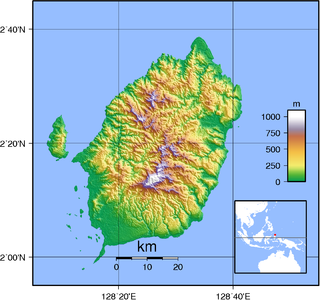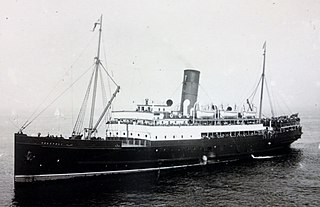
Ambon Island is part of the Maluku Islands of Indonesia. The island has an area of 743.37 km2 (287.02 sq mi) and is mountainous, well watered, and fertile. Ambon Island consists of two territories: the city of Ambon to the south and various districts (kecamatan) of the Central Maluku Regency to the north. The main city and seaport is Ambon, which is also the capital of Maluku province, while those districts of Maluku Tengah Regency situated on Ambon Island had a 2020 Census population of 128,069. Ambon has an airport and is home to the Pattimura University and Open University, state universities, and a few private universities, which include Darussalam University and Universitas Kristen Indonesia Maluku (UKIM).

HMAS Ipswich (J186/B244/A118), named for the city of Ipswich, Queensland, was one of 60 Bathurst-class corvettes built during World War II and one of 20 built on Admiralty order but manned by personnel of and later commissioned into the Royal Australian Navy (RAN).

Balikpapan is a seaport city in East Kalimantan, Indonesia. Located on the east coast of the island of Borneo, the city is the financial center of Kalimantan. Balikpapan is the city with the largest economy in Kalimantan with an estimated 2016 GDP at Rp 73.18 trillion. The city has the third busiest airport in Kalimantan after that in Banjarmasin and Pontianak, namely Sultan Aji Muhammad Sulaiman Sepinggan Airport. Port of Semayang was the second busiest seaport in East Kalimantan, after that in Samarinda.
Civil Air Transport (CAT) was a Nationalist Chinese airline, later owned by the U.S. Central Intelligence Agency (CIA), that supported United States covert operations throughout East and Southeast Asia. During the Cold War, missions consisted in assistance to "Free World" allies according to the Mutual Defense Assistance Act of 1949.

Permesta was a rebel movement in Indonesia that was declared on 2 March 1957 by civil and military leaders in East Indonesia. Initially the center of the movement was in Makassar, which at that time was the capital of the province of Sulawesi. However, support for the movement in South Sulawesi gradually dissipated, forcing the headquarters to move to Manado in North Sulawesi.

HMS Aurochs (P426/S26), was an Amphion-class submarine of the Royal Navy, built by Vickers Armstrong and launched 28 July 1945. Her namesake was the aurochs, an extinct Eurasian wild ox ancestral to domestic cattle and often portrayed in cave art and heraldry.

Allen Lawrence Pope was an American military and paramilitary aviator. He rose to international attention as the subject of a diplomatic dispute between the United States and Indonesia after the B-26 Invader aircraft he was piloting in a Central Intelligence Agency (CIA) covert operation was shot down over Ambon on May 18, 1958, during the "Indonesian Crisis".
Silvanus was a steam tanker built in 1920–1921 by the Southwestern Shipbuilding & Drydock Company of San Pedro for the Anglo-Saxon Petroleum Company with the intention of transporting oil and petroleum products between Dutch East Indies and various destinations in Europe and the Far East. The tanker was employed in this capacity through the first part of 1926. In April 1926 Silvanus collided with the tanker Thomas H. Wheeler in the Mississippi River, resulting in the explosion and death of 26 seamen. Silvanus was declared a total loss and sold at auction to the newly formed Petroleum Navigation Company of Texas. The tanker was rebuilt and renamed Papoose and started operating in March 1927. In March 1942, she was attacked by German U-boat U-124 off the coast of North Carolina. The ship drifted for several days and eventually sank in 200 feet (61 m) of water off Oregon Inlet.
HMS Heartsease was a Flower-class corvette of the Royal Navy. She served with both the Royal Navy and the United States Navy during the Second World War, with the latter navy as USS Courage. She then spent several years under a succession of names in civilian service. In 1957 she was chartered on behalf of Indonesian rebels to smuggle rubber, copra and matériel. The Indonesian Air Force intercepted and sank her off the coast of Minahasa in North Sulawesi in December 1958.

Morotai Island is an island in the Halmahera group of eastern Indonesia's Maluku Islands (Moluccas). It is one of Indonesia's northernmost islands.

Eagle Oil and Shipping Company was a United Kingdom merchant shipping company that operated oil tankers between the Gulf of Mexico and the UK. Weetman Pearson, 1st Viscount Cowdray founded it as the Eagle Oil Transport Company in 1912 and sold it to Royal Dutch Shell in 1919. It was renamed Eagle Oil and Shipping Company in about 1930, and remained a separate company within the Royal Dutch Shell group until it was absorbed in 1959.

RMS Snaefell (III) – the third ship in the line's history to be so named – was a packet steamer operated by the Isle of Man Steam Packet Company from 1910 to 1914. She was then acquired by the Admiralty at the outbreak of the First World War, until she was torpedoed and sunk in the Mediterranean on 5 June 1918.
William Henry Beale Jr. was a US military and paramilitary aviator. In the Second World War, he was in the USAAF and flew bombing missions in the northern Pacific theater. In the Permesta rebellion in Indonesia in 1958 he flew bombing missions for the CIA. His career ended on a CIA covert mission in Laos in 1962 when he was killed in a plane crash.
MV Daronia was a 1930s British oil tanker owned by Anglo-Saxon Petroleum, a British subsidiary of Royal Dutch Shell. She was launched in 1938 by Hawthorn, Leslie in North East England and completed in 1939. She was one of a class of 20 similar tankers built for Anglo-Saxon.
MV Dromus was a 1930s British oil tanker owned by Anglo-Saxon Petroleum, a British subsidiary of Royal Dutch Shell. She was launched in September 1938 by Harland and Wolff at Belfast in Northern Ireland. She was one of a class of 20 similar tankers built for Anglo-Saxon.
SS Aquila was a cargo ship built in Britain in 1940 for Stavros Livanos' Trent Maritime Co Ltd. by William Gray & Company. An identical sister, Duke of Athens, was built for Trent at the same time.
SS Flying Lark was a ship built in Fredrikstad, Norway in 1915 as the banana boat SS Honduras. Over a 43 year career that spanned oceans and seas the world over she had 10 owners, eight names and a succession of different managers.
SS Armonia was a 2,740 GRT cargo ship built in Britain in 1924 for the Moor Line as SS Tullochmoor. Scrapped in 1960, she had eight sets of owners, managers and names over her 26-year career.










